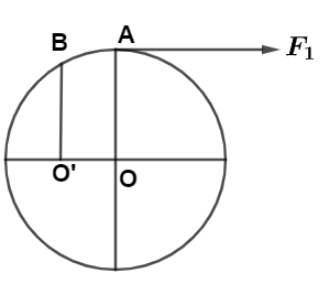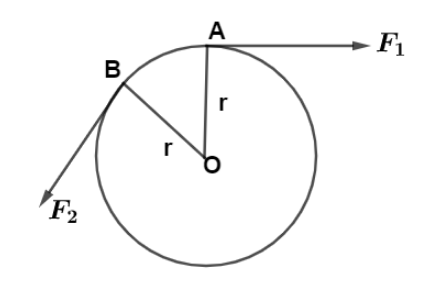
The wheel shown in the diagram has a fixed axle passing through O. The wheel is kept stationary under the action of

(i) Horizontal force
(ii) A vertical force
Show the direction of force

Answer
416.7k+ views
Hint:In order to solve this question we need to understand torque. Torque is defined as a rotating force which causes different bodies to rotate. It is mathematically defined as the cross product of force and the perpendicular distance from the axis to the line of action of force. It is a vector quantity and direction of rotation of circular bodies can be found using cross product rule, which states that for direction stretch your palm in direction of first vector and rotate fingers in direction of second vector, so the thumb direction is torque direction.
Complete step by step answer:
Since in figure, a horizontal force
Since
Here, the negative sign denotes the torque due to
For wheel to stationary, there must be torque in outward direction,

Consider a force
Since
Here, the positive sign denotes the torque due to
So in this way net torque is zero, and hence the wheel is stationary, so it cannot rotate.
Note: It should be remembered that here we have assumed that there would be no translation motion and also there would be no friction means the wheel is kept at a smooth surface. Also we assumed that the point of contact of the wheel is at rest and since there is no translation motion, the wheel could not drag itself. Also the direction of torque is determined using the cross product direction rule.
Complete step by step answer:
Since in figure, a horizontal force
Since
Here, the negative sign denotes the torque due to
For wheel to stationary, there must be torque in outward direction,

Consider a force
Since
Here, the positive sign denotes the torque due to
So in this way net torque is zero, and hence the wheel is stationary, so it cannot rotate.
Note: It should be remembered that here we have assumed that there would be no translation motion and also there would be no friction means the wheel is kept at a smooth surface. Also we assumed that the point of contact of the wheel is at rest and since there is no translation motion, the wheel could not drag itself. Also the direction of torque is determined using the cross product direction rule.
Recently Updated Pages
Master Class 11 Economics: Engaging Questions & Answers for Success

Master Class 11 Business Studies: Engaging Questions & Answers for Success

Master Class 11 Accountancy: Engaging Questions & Answers for Success

Master Class 11 English: Engaging Questions & Answers for Success

Master Class 11 Computer Science: Engaging Questions & Answers for Success

Master Class 11 Maths: Engaging Questions & Answers for Success

Trending doubts
Which one is a true fish A Jellyfish B Starfish C Dogfish class 11 biology CBSE

State and prove Bernoullis theorem class 11 physics CBSE

1 ton equals to A 100 kg B 1000 kg C 10 kg D 10000 class 11 physics CBSE

In which part of the body the blood is purified oxygenation class 11 biology CBSE

One Metric ton is equal to kg A 10000 B 1000 C 100 class 11 physics CBSE

Difference Between Prokaryotic Cells and Eukaryotic Cells




